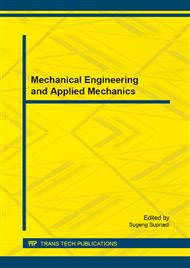p.13
p.21
p.29
p.35
p.45
p.51
p.57
p.63
p.71
A Comparative Study of the Damping Force and Energy Absorbtion Capacity of Regenerative and Conventional-Viscous Shock Absorber of Vehicle Suspension
Abstract:
This paper presents a comparative study of the damping force and energy absorbtion capacity of a typical conventional-viscous and a regenerative shock absorber for vehicle suspension. Regenerative shock absorber (RSA) is a shock absorber which can regenerate the dissipated vibration energy from vehicle suspension into electricity. In this research, a prototype of regenerative shock absorber was developed, its damping force and energy absorbtion capacity were tested, and the results were analized and compared with those of a typical conventional-viscous shock absorber. The regenerative and viscous shock absorber were compressed and extended in various excitation frequency using damping force testing equipment to obtain force-velocity and the force-displacement curves. The force-velocity and force-displacement curves indicate the damping force and energy absorbtion capacity of the shock absorber. The results show that the damping force of the typical-viscous shock absorber closed to linear at all exciation frequencies. For regenerative shock absorber, nonlinearity and large hysteresis area of the damping force occur at all excitation frequencies. Further, the energy absorbtion capacity of the typical-viscous shock absorber shows an elliptical area with the compression part bigger than the extension one, while those of the regenerative shock absorber shows an asymmetric square area, which indicates a smaller energy absorbtion capacity. These phenomena indicate the significant effect of implementing dry friction damper and elctrical damper to the characteristics of regenerative shock absorber.
Info:
Periodical:
Pages:
45-50
Citation:
Online since:
April 2015
Authors:
Price:
Сopyright:
© 2015 Trans Tech Publications Ltd. All Rights Reserved
Share:
Citation:


